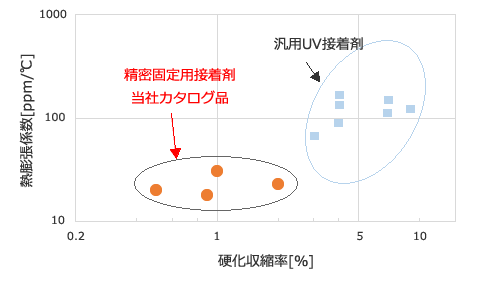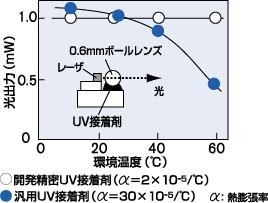Feature
- Adhesive fixation on the order of submicrons is possible because there is very little change in fixing position due to curing or temperature changes.
*Low coefficient of thermal expansion (40 ppm/°C or less)
- AT9290F becomes transparent after curing
- High reliability that withstands heat cycle tests (-40 to 85°C)
- High heat resistance (260°C) that withstands solder reflow processing

[Usage example] Fixing micro ball lenses

Image diagram

Temperature characteristics of LD module
Characteristic value
| model number [main component] |
viscosity (mPa・S) |
Curing conditions [Irradiation intensity, time] |
cure shrinkage (%) |
Glass-transition temperature Tg (°C) |
coefficient of thermal expansion (ppm/°C) |
Adhesion strength (kgf/cm2) |
Features |
|---|---|---|---|---|---|---|---|
| AT4291A [Epoxy] (*1) |
25,000 | 100mW/ cm2 10 minutes |
2 | 206 | 23 | >116 | low viscosity |
| AT9290F [Epoxy] (*1) |
45,000 | 100mW/ cm2 10 minutes |
1 | 140 | 31 | >200 | Transparent after curing (Large curing depth) |
| AT3862P [Epoxy] (*1) |
180,000 | 100mW/ cm2 10 minutes |
0.5 | 195 | 20 | >210 | Small cure shrinkage high viscosity |
| AT3916P [Epoxy] (*1) |
36,000 | 100mW/ cm2 10 minutes |
0.9 | 233 | 18 | >220 | low viscosity |
The characteristic values in the table are sample measurement values, not guaranteed values.


 close up
close up